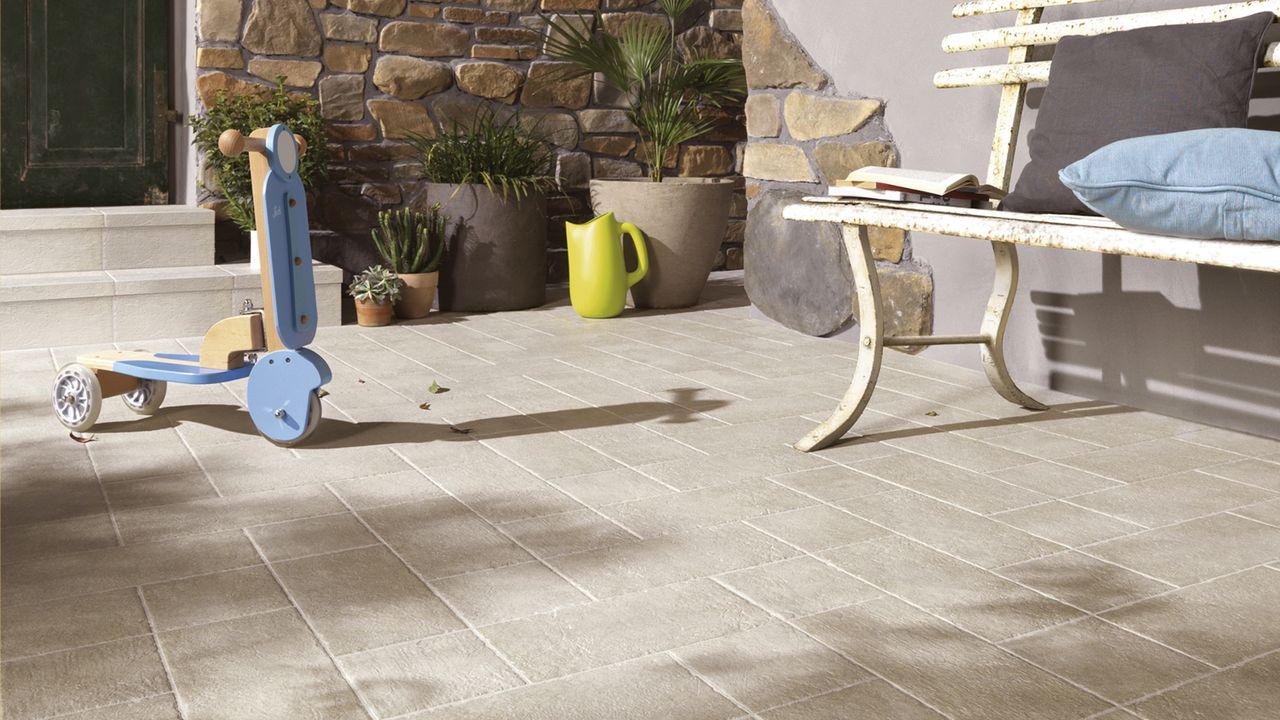

Outdoor tiles instantly make patio areas look smart and attractive. One of the most important elements of patio design, tiles will affect the look and feel of your space more than any other hard landscaping element, and they need to be weatherproof and slip-proof. Read on and find out how to choose outdoor tiles correctly.
Find more garden ideas at our dedicated page.
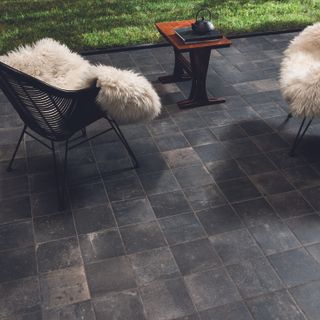
Medici Nonni Cobbles in porcelain, £120 per square metre, SACW Paving
How to choose the material of outdoor tiles
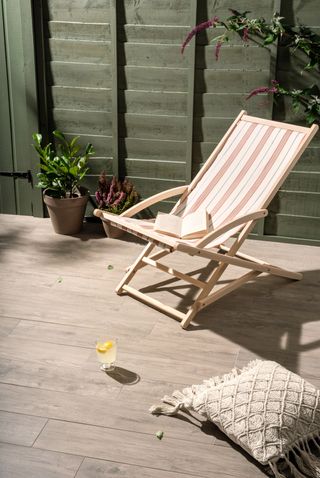
Just as inside your home, you can opt for manmade tiles or real stone versions for the exterior. Natural stone is generally the more expensive option, but if you want its inherent pattern and colour variations and the knowledge that each tile is unique, it’s the option to invest in. Manmade tiles – think porcelain tiles – can have the appearance of a real stone, look like wood, or create a pleasing neutral surface, plus there are patterned versions that can dress up a patio or path.
Want to make a strong link between outdoors and the interior of your home? There are floor tiles appropriate for both areas so you can create a continuous surface, for example from a kitchen extension with bifold doors or sliding versions to the garden.
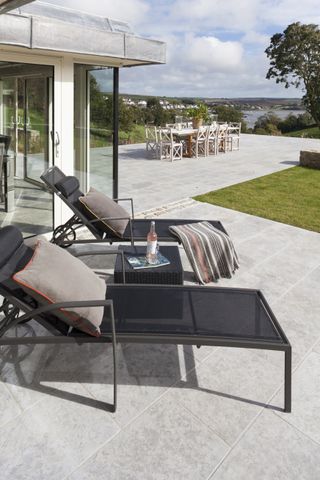
Milan tumbled outdoor limestone, from £70.80 per square metre, Mandarin Stone
Natural stone outdoor tiles
Tiles made from limestone, slate, sandstone, granite and marble are all possibilities for an outside area if natural stone is a must-have. Natural stone is porous, so will need sealing.
Slate comes in attractive finishes from black and deep grey to livelier tiles featuring tones like green or rust. It can complement older homes, or create a contemporary look, so it’s very versatile. It’s highly durable, too. Slate’s uneven surface is a benefit outdoors because of its anti-slip properties, and a textured riven finish maximises this quality.
Limestone offers the choice of beiges, creamier tones and greys underfoot. An outdoor limestone tile should have a textured surface so it’s not slippery in the wet. Look out for tumbled or riven versions. Always verify that a limestone you like is an outdoor grade stone; some can’t cope with frost.
Sandstone – including the native version called Yorkstone – is a popular choice for outdoor areas. Colours include creams and greys. The latter are easier to keep clean, while cream can be harder work. It has good slip resistance in any case, so a smooth honed finish is possible, as well as more textural finishes that make it look rustic.
Granite needs a textured surface to prevent issues with slipperiness when it’s wet. In grey or black tones, it can provide a timeless backdrop to a dining or seating area in the garden.
Marble is sometimes used for outdoor tiles. Be careful to choose a tile specifically offered for outdoor use, and a textured finish to help prevent slips.
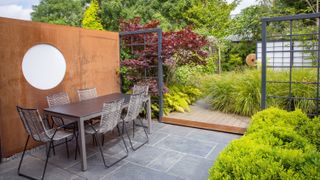
Manmade outdoor tiles
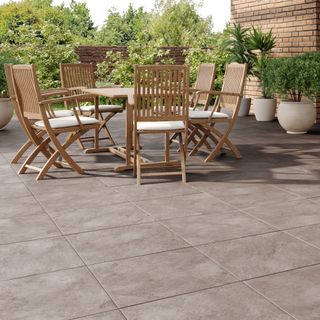
Luna Copper outdoor matt porcelain slab tiles, £29.99 per square metre, Tile Mountain
Manmade outdoor tiles can prove a budget-friendly and good-looking option. Porcelain and terracotta may be used to create the patio or garden path look you’re after.
Porcelain tiles offer a host of benefits. They aren’t porous, so cracking caused by frost isn’t an issue. Being non-porous also makes them easy to keep clean. They are resistant to scratching and fading in the sun, too. Choose a finish that offers slip-resistance outside and if kids or those who are infirm are part of the household, a textured finish is best.
How to choose ceramic and porcelain floor tiles.
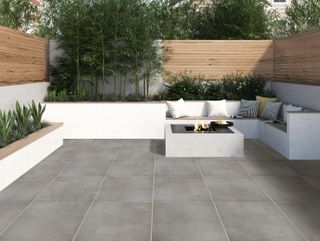
Ohio Silver Outdoor Tiles, £34.99 per sqm, Tile Mountain
Porcelain tiles can look like wood or natural stone, or they can be patterned. Use them to create a Mediterranean-style vibe on the patio, or give a front path back its period credentials with Victorian-style pattern.
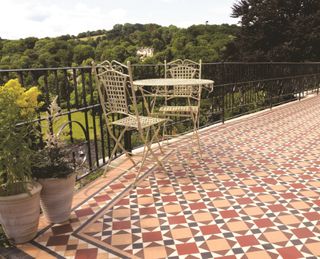
Terracotta and quarry tiles offer the warmth of brick reds, brown or greyer tones. They’re best for period homes or to complement a cottage-style garden. As with other tiles, check the version you like the look of is appropriate for outdoor use.
How to choose quarry and terracotta floor tiles.
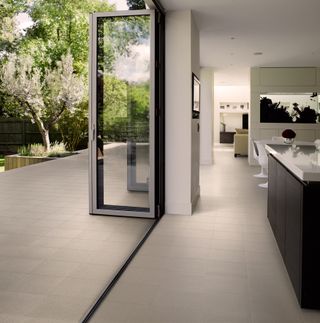
Cava Unglazed Victorian porcelain tiles, £34.95 per square metre, Walls and Floors
Using the same tiles indoors and outdoors
Laying the same tiles at the same level inside the house and out, and combining with bi-folding or sliding doors, can create a seamless link between the two and the illusion that a room is much larger than it really is. Many companies offer tiles that will achieve this effect in both natural stone and porcelain.
As an alternative to using exactly the same tile in the same finish, consider as an alternative the same tile but in two different finishes with a more textural finish outside to maximise the tile’s anti-slip aspect.
Some tiles are sold in specific indoor-outdoor ranges that make selecting easy, but if not, always check that the tile you want indoors is suitable for outdoors before getting out the plastic.
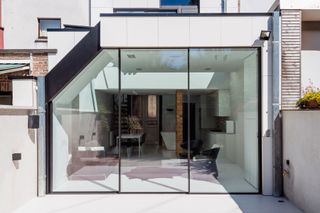
What tiles should be used around pool or hot tub areas?
If you have a swimming pool or hot tub, you'll want something that can handle being constantly wet and something that won't get too slippery. Ceramic tiles win on both counts, although some types of natural stone can also be used. Travertine is commonly used for pool areas, but it will need to be honed, filled, and sealed with a waterproof sealant. Never use marble around hot tubs or pool as it gets very slippery when wet.
Who can fit outdoor tiles?
Fitting outdoor tiles is something a competent DIYer can take on. The approach you take will depend on whether you are laying natural stone or porcelain tiles, or the tile is from a special easy-to-fit range. If you don’t have the appropriate equipment or are uncertain about laying tiles outside, call on a professional.
Read more:
Join our newsletter
Get small space home decor ideas, celeb inspiration, DIY tips and more, straight to your inbox!

Sarah is a freelance journalist and editor writing for websites, national newspapers, and magazines. She’s spent most of her journalistic career specialising in homes – long enough to see fridges become smart, decorating fashions embrace both minimalism and maximalism, and interiors that blur the indoor/outdoor link become a must-have. She loves testing the latest home appliances, revealing the trends in furnishings and fittings for every room, and investigating the benefits, costs and practicalities of home improvement. It's no big surprise that she likes to put what she writes about into practice, and is a serial house revamper. For Realhomes.com, Sarah reviews coffee machines and vacuum cleaners, taking them through their paces at home to give us an honest, real life review and comparison of every model.
-
 How to make compost — 8 easy steps gardening pros always use
How to make compost — 8 easy steps gardening pros always useLearn how to make compost at home in seven easy steps, whether you have a bin or want to create a compost heap. We've asked pros for their top tips
By Eve Smallman Published
-
 Planting ornamental grasses — the best types experts love and how to grow them
Planting ornamental grasses — the best types experts love and how to grow themWe've got you covered on planting ornamental grasses, speaking to experts about what ones to grow, how to grow them, and factors to consider
By Eve Smallman Last updated
-
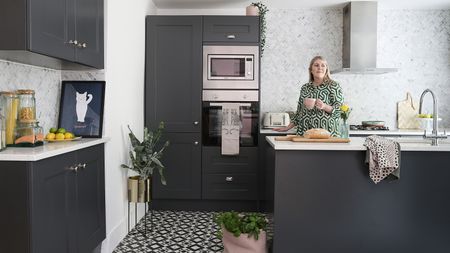 "Grotty" terrace is transformed with French flair and Ibiza vibes in the garden
"Grotty" terrace is transformed with French flair and Ibiza vibes in the gardenEsther Pillans' tired-looking Victorian terraced house was given a makeover with a touch of Parisian chic
By Ellen Finch Published
-
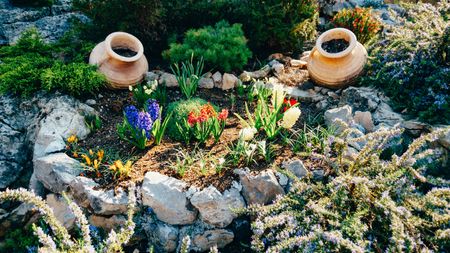 Rock garden ideas – 10 DIY ways to create a rockery
Rock garden ideas – 10 DIY ways to create a rockeryThese rock garden ideas are suitable for outdoor spaces big and small. Create your own rockery on a lawn or even on a balcony with just a few materials.
By Anna Cottrell Published
-
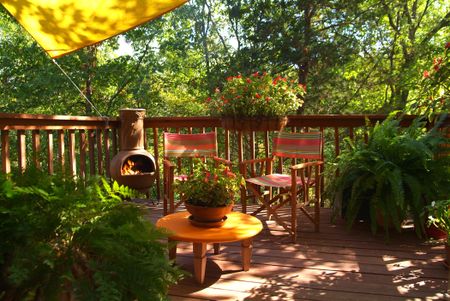 Cabin fever? These chimineas will extend the life of your patio
Cabin fever? These chimineas will extend the life of your patioThis cold-weather season, cozy up to our favorite chimineas!
By Brittany Romano Published
-
 5 outdoor summer essentials to prove Society6 is your one-stop-shop this season
5 outdoor summer essentials to prove Society6 is your one-stop-shop this seasonCheck off all of your outdoor summer essentials by shopping exclusively at Society6.
By Brittany Romano Published
-
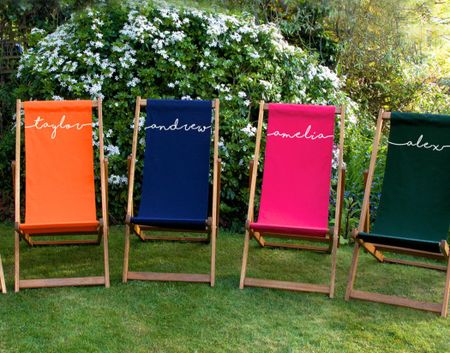 The first-ever Etsy outdoor sale is happening now, and we're buying these 5 items
The first-ever Etsy outdoor sale is happening now, and we're buying these 5 itemsFor a limited time, this Etsy outdoor sale will give your backyard the facelift it needs — at a fraction of the cost.
By Brittany Romano Published
-
 The benefits of houseplants – 8 feel-good ways plants help your health
The benefits of houseplants – 8 feel-good ways plants help your healthEnjoy the many benefits of houseplants. Air-purifying, anxiety-soothing, mood boosting and more positive vibes.
By Camille Dubuis-Welch Published